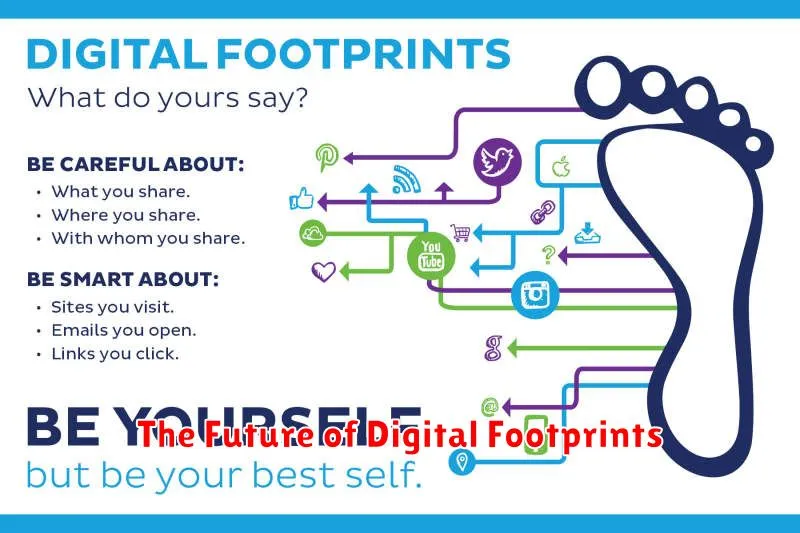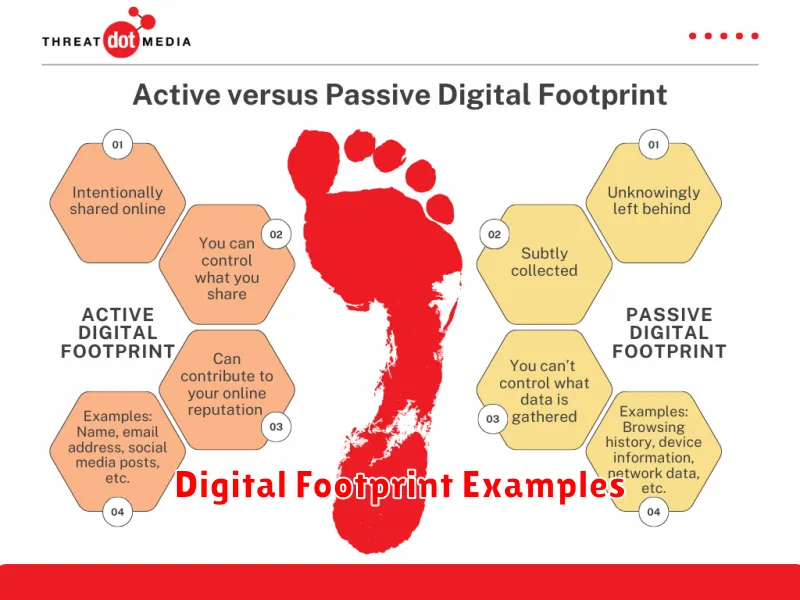In today’s interconnected world, nearly every online interaction leaves a trace. This collective trace forms your digital footprint, a comprehensive record of your online activity. Understanding your digital footprint is crucial in the digital age. It encompasses everything from social media posts and online purchases to browsing history and search queries. This digital trail can impact various aspects of your life, including your professional reputation, personal relationships, and even future opportunities. Learning to manage your digital presence effectively is essential for safeguarding your privacy and presenting a positive online image. This article will delve into what constitutes a digital footprint, why it matters, and how you can take control of your online narrative.
Your digital footprint can be either active or passive. An active digital footprint comprises information you intentionally share online, such as comments, posts, and profile information. A passive digital footprint, on the other hand, consists of data collected without your direct involvement, including your IP address, browsing history, and cookies. Both types contribute to your overall digital presence and can significantly influence how you are perceived by others, including potential employers, educational institutions, and even future partners. By understanding the components of your digital footprint and taking proactive steps to manage it, you can shape a positive online identity that accurately reflects who you are and supports your personal and professional goals. This article provides valuable insights into understanding and managing your digital footprint effectively.
What is a Digital Footprint?
A digital footprint is the trail of data you leave behind as you use the internet and digital devices. Every time you visit a website, post on social media, send an email, or even conduct an online search, you are contributing to your digital footprint. Think of it as your online identity, a record of your activities and interactions in the digital sphere.
This data can include anything from the content you create, like photos and videos, to the information you share, such as your location and contact details. It also encompasses data generated passively, like your IP address, browsing history, and the type of device you use.
Essentially, your digital footprint is a cumulative record of your online presence, consciously or unconsciously built over time. This information can be accessed and analyzed by various parties, including potential employers, educational institutions, and even marketing companies.
Types of Digital Footprints
Digital footprints are broadly categorized into two types: passive and active. Understanding the difference between these types is crucial for managing your online presence.
A passive digital footprint is created when data is collected without your direct involvement. This includes data collected through website cookies tracking your browsing history, metadata attached to files you download, or your IP address being logged when you visit a website. You may not even be aware a passive digital footprint is being created.
An active digital footprint is created when you intentionally share information online. This includes posting on social media, sending emails, filling out online forms, or creating accounts on various platforms. You are actively contributing to your digital footprint when you engage in these activities.
The Impact of Your Digital Footprint
Your digital footprint has a significant impact on various aspects of your life, influencing opportunities and perceptions. It can affect your personal and professional reputation, impacting future employment prospects, relationships, and even educational opportunities.
Positive digital footprints can open doors to networking opportunities, collaborations, and career advancement. A strong online presence showcasing skills and accomplishments can attract potential employers and clients.
Conversely, a negative digital footprint can create obstacles. Inappropriate or controversial content can damage your reputation and lead to missed opportunities. Privacy breaches resulting from a careless digital footprint can also expose you to identity theft and other risks.
It’s crucial to recognize that your digital footprint is constantly evolving and can have long-term consequences. Therefore, actively managing and cultivating a positive online presence is essential in today’s digital age.
Managing Your Online Presence
Managing your digital footprint is a proactive process that requires consistent effort. It involves regularly reviewing your online activity, controlling your privacy settings, and being mindful of the content you share.
Start by searching for yourself online to see what information is readily available. This can help you identify areas that need attention. Regularly review your social media profiles and delete any posts or comments that no longer reflect who you are or your professional goals.
Adjust your privacy settings on all social media platforms and online accounts. Be selective about the information you share publicly and consider limiting the visibility of certain posts or profiles. Strong passwords and two-factor authentication add an extra layer of security and protect your accounts from unauthorized access.
Before posting anything online, consider the potential impact it could have on your reputation. Always remember that what you share online can remain accessible indefinitely.
Protecting Your Privacy Online
Protecting your digital privacy requires proactive measures. Understanding how your data is collected and used is the first step. Regularly review the privacy settings on your social media accounts and other online platforms. Be mindful of the information you share publicly. Consider using strong, unique passwords for each account and enabling two-factor authentication wherever possible.
Browser extensions focused on privacy can help block trackers and limit data collection. Be cautious of clicking on suspicious links or downloading files from untrusted sources, as these can lead to malware that compromises your privacy. Using a Virtual Private Network (VPN) can encrypt your internet traffic and mask your IP address, adding an extra layer of security. Finally, stay informed about current online privacy threats and best practices to keep your information safe.
Tips for Maintaining a Positive Digital Footprint
Cultivating a positive digital footprint requires proactive management and consistent awareness of your online activities. Here are some key tips:
Think Before You Post
Pause and consider the content, tone, and potential impact of your posts before sharing. Ask yourself if it’s something you’d be comfortable with a future employer or family member seeing.
Review Privacy Settings
Regularly check the privacy settings on your social media accounts and other online platforms. Understand who can see your information and adjust accordingly.
Be Respectful and Considerate
Engage in positive and constructive interactions online. Avoid negativity, personal attacks, and inflammatory language. Treat others with the same respect you’d expect in person.
Regularly Google Yourself
Periodically search your name to see what information about you is readily available. This allows you to monitor your digital footprint and address any potential concerns.
Common Mistakes to Avoid
Oversharing personal information. Publicly posting sensitive details like your full address, phone number, or financial information can make you a target for identity theft or other malicious activities. Think carefully before sharing anything online that you wouldn’t want a stranger to know.
Ignoring privacy settings. Social media platforms and other online services offer privacy controls. Take the time to understand and configure these settings to limit who can see your posts and information.
Posting impulsively. Avoid posting in anger or when emotional. Think about how your words might be interpreted by others, and consider the potential long-term consequences of your posts.
Using weak passwords. Using the same password across multiple accounts or choosing easy-to-guess passwords makes you vulnerable to hacking. Create strong, unique passwords for each of your online accounts.
Neglecting to review your digital footprint. Regularly search for your name online to see what information is publicly available about you. This allows you to address any inaccuracies or potentially damaging content.
The Future of Digital Footprints

The future of digital footprints is marked by increasing complexity and permanence. As technology evolves, the amount of data generated by individuals will continue to grow exponentially. This includes data from emerging technologies like the Internet of Things (IoT), wearable devices, and virtual and augmented reality experiences.
Data analysis and artificial intelligence will play a significant role in shaping how digital footprints are understood and utilized. These technologies will be able to process and interpret vast datasets, potentially leading to more personalized experiences, but also raising concerns about profiling and prediction.
The concept of data ownership and control will become increasingly important. Individuals may have more options to manage and control their data, with a greater emphasis on data privacy and security. Regulations and policies surrounding data collection and usage will likely evolve to address the changing digital landscape.
The blurring lines between the physical and digital worlds will further impact our digital footprints. Actions in the physical world, such as attending events or visiting locations, will be increasingly linked to our online identities.
Digital Footprint Examples

Here are some examples illustrating various aspects of a digital footprint:
Social Media Activity
Posting a photo on Instagram, commenting on a friend’s Facebook post, or sharing an article on Twitter all contribute to your digital footprint. These actions create a record of your interests, opinions, and social connections.
Online Shopping
Purchasing items online, leaving product reviews, and browsing e-commerce websites leave traces of your consumer behavior. This data can be used to personalize ads and recommendations.
Online Search History
The keywords you use when searching online are recorded. This search history can reveal your interests, concerns, and information-seeking habits.
Email Communication
Sending and receiving emails creates a record of your correspondence. The content of these emails, including the sender, recipient, and message body, becomes part of your digital footprint.

